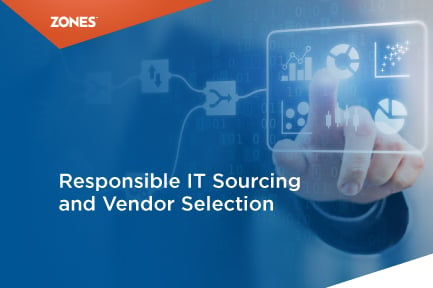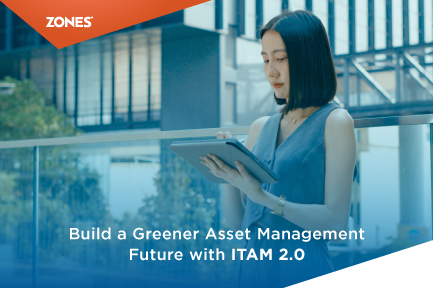5 Dos and Don'ts of Sustainable IT Sourcing and Vendor Selection
Technology today has become an integral part of our lives, driving innovation and shaping how we live and work. However, as our reliance on...
4 min read
Gerry Doherty : Apr 18, 2024 11:55:06 AM

Climate change and environmental issues are major global challenges. This is why there is a growing recognition to mitigate the environmental impact and transition toward a more sustainable future.
Organizations worldwide are increasingly adopting sustainability and environmental, social, and governance (ESG) practices due to this increasing concern over the rising footprints. Consumers, investors, and regulators are now demanding real efforts from companies to lessen their impact on the environment while being transparent about their contribution to global ESG initiatives. According to the EU Corporate Sustainability Reporting Directive (CSRD), non-EU companies (31% based in the U.S.A.) need to publicly report their sustainability practices and work toward reducing their environmental footprint.
Click on the Image to Watch the Webinar
As we move ahead in 2024, addressing the environmental impact of digital technologies is extremely important. With accelerating technological transformation, organizations must take a proactive stance in minimizing their ecological footprint. Failure to do so not only leads to substantial environmental consequences but also poses significant risks to an organization's reputation, competitiveness, and long-term viability.
One area that can positively impact and influence sustainability outcomes in organizations’ IT operations is IT asset management (ITAM).
IT asset management, with its ability to provide visibility, control, and optimization of IT assets, plays a pivotal role in enabling organizations to meet sustainability goals and unlock new opportunities for innovation, cost savings, and competitive advantage.
ITAM is pivotal in enabling organizations to understand, manage, and optimize their IT assets throughout their lifecycle, from procurement to maintenance and disposal. By leveraging ITAM best practices, organizations can significantly reduce their environmental footprint and pave the way for sustainable IT.
It’s interesting to note that there are several ways organizations conduct their IT asset management practices that culminate in a sustainable and greener future for their IT.
The first step toward sustainable IT operations is developing a well-defined policy outlining your organization's commitment to sustainability in IT asset management. This policy should include clear goals for reducing carbon impacts over time, addressing factors such as IT equipment energy efficiency and responsible disposal practices for end-of-life assets.
|
Also Read Achieving Sustainability and ESG Excellence in IT: Zones’ Journey |
Prolonging the useful life of IT assets is a key component of sustainable IT operations. Your organization can extend the lifespan of hardware resources such as smartphones, computers, and servers by repairing, refurbishing, and reusing them. By implementing robust asset lifecycle management practices, you can minimize electronic waste and reduce the demand for new resources, thereby reducing their environmental impact.
ITAM tools and practices empower organizations to optimize the use of IT assets and cloud resources, thereby minimizing energy consumption and building inefficiencies. By monitoring and managing hardware, software, network resources, and cloud usage, you can identify and eliminate inefficiencies, such as underutilized or idle assets, reducing their overall energy footprint.
ITAM plays a critical role in integrating sustainability into the procurement process. By evaluating factors such as energy efficiency of devices, repairability, longevity of systems, and vendor sustainability practices, your organization can make informed purchasing decisions that align with your sustainability goals. Additionally, you can consider outsourcing your IT supply chain to a responsible vendor that ensures timely fulfillment and availability of devices, reducing emissions through efficient transport and logistics.
|
A smart tool for planning and managing the demand, supply, and inventory of your IT assets |
Proper disposal and recycling of end-of-life IT assets is essential for reducing e-waste and its associated environmental impacts. ITAM provides visibility into an organization's IT asset inventory, allowing for accurate tracking and management of assets nearing the end of life. Teams can work closely with certified IT asset disposal (ITAD) server providers to ensure proper handling, data sanitization, and environmentally responsible disposal or recycling of retired assets.
Virtualization and cloud computing can significantly reduce an organization's energy consumption and carbon footprint by consolidating workloads and optimizing resource utilization. ITAM plays a crucial role in identifying opportunities for virtualization and cloud migration, as well as managing and monitoring the virtualized and cloud environments to ensure efficient resource allocation and utilization.
ITAM teams can work with IT operations to implement power management strategies that reduce energy consumption across the IT infrastructure. This may include setting power-saving modes, scheduling sleep or hibernation cycles for idle devices, and consolidating workloads to minimize the number of active servers or other hardware components.
|
Also Read |
Accurately measuring your organization's direct and indirect emissions is crucial for establishing an emissions baseline. ITAM plays an important role in this process by providing visibility into how IT resources, including hardware, software, and cloud services, are being utilized. This data enables organizations to track their progress toward long-term sustainable change and document improvements for regulatory and reporting needs.
By facilitating remote work and collaboration tools, organizations reduce their carbon footprint associated with employee commuting and business travel. ITAM teams can ensure remote workers have access to the necessary IT resources, such as laptops, software, and secure network connections, while also managing and securing these distributed assets effectively.
By leveraging IT asset usage data and insights, organizations can accurately measure and report on the environmental impact of their IT operations. ITAM teams can track metrics such as energy consumption, carbon emissions, e-waste generated, and the success of sustainability initiatives. This data can be used to set targets, measure progress, and communicate your organization's sustainability efforts to stakeholders.
By incorporating these strategies, IT asset management teams can provide a comprehensive framework for driving sustainable IT, addressing various aspects of your organization's environmental footprint and fostering a culture of environmental responsibility.
|
Also Read |
Implementing sustainable IT operations is a journey, and ITAM serves as a guiding compass.
It plays a multifaceted role in enabling sustainable IT. From establishing robust sustainability policies to optimizing resource utilization and extending the lifespan of IT assets, ITAM helps your organization navigate the complexities of sustainable IT operations.
By harnessing the power of ITAM, your organizations can pave the way for a future where technological progress and environmental stewardship go hand in hand, creating a more sustainable and prosperous world for generations to come.
If you are looking to implement sustainable IT asset management practices for your organization,

Technology today has become an integral part of our lives, driving innovation and shaping how we live and work. However, as our reliance on...

The management of IT assets has undergone a significant transformation in recent years. What began as simple inventory tracking has evolved into a...

Today, businesses operating across different locations face unique challenges in IT asset management (ITAM) with respect to tracking and managing...